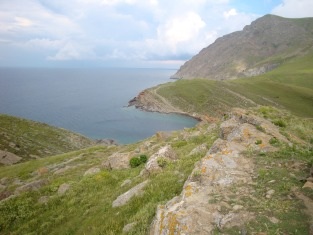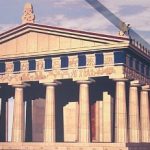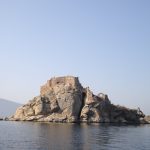The old Greek İmbros Population: 6,000
Market day:
Festival: 15 August, Feast Day of Virgin Mary
Favourite son: Patriarch Bartholomew I
As one of Turkey’s only two inhabited Aegean islands, mountainous Gökçeada was exempted from the population exchange imposed on Turkey and Greece by the terms of the Treaty of Lausanne that ended the Turkish War of Independence in 1923. As a result it still has a small Greek-speaking population especially in the inland villages.
Gökçeada has always been more remote than it appears on the map, not least because ferries were unable to reach it in bad weather. Until quite recently foreigners were not allowed to visit it either which delayed the development of a tourist industry. Now the island has signed up to the Slow City movement which might help it rein in the worst excesses of tourism development.
In summer you should have no trouble getting to Gökçeada either from Çanakkale or Kabatepe (a much shorter crossing) on the Gallipoli Peninsula. However, arriving here is quite unlike arriving on Bozcaada, the other inhabited Aegean island, with absolutely no sign of habitation near the harbour at Kuzu Limanı.
Around the island
Buses run you straight to Gökçeada Town, a messy modern settlement which mainly acts as a transit point for those heading on to the small resort of Kaleköy. If you will be visiting any other Turkish resorts you should probably give Kaleköy a miss since, the ruins of a 16th-century castle and a small chapel aside, it’s little more than a pair of large hotels with restaurants attached.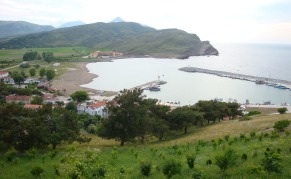
Less obvious and completely different is Yukarı Kaleköy (Upper Kaleköy), a stone-built Greek village above the harbour that huddles beneath the ruins of a Genoese castle whose walls once ran right down to the sea.
Here, the Yakamoz Motel offers a stunning vista across a rose-filled garden to the harbour and the surrounding mountains. It would be hard to imagine a more inviting setting, and a programme of village regeneration is about to unleash a whole new set of pensions in pretty stone-built houses nearby.
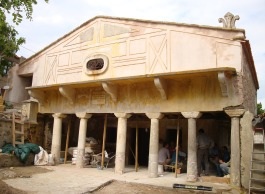 The church that was once the heart of the village is being restored. The cartouche above the portico dates it back only to 1949, when those responsible for it could have had no idea how short a time their community had left on the island. The portico is lined with marble columns and capitals clearly taken from a Byzantine ruin, suggesting that as recently as the 1940s such pieces were still available for use as building materials.
The church that was once the heart of the village is being restored. The cartouche above the portico dates it back only to 1949, when those responsible for it could have had no idea how short a time their community had left on the island. The portico is lined with marble columns and capitals clearly taken from a Byzantine ruin, suggesting that as recently as the 1940s such pieces were still available for use as building materials.
Right beside the church, the old Greek café has been beautifully restored and reopened for business. On the hillside above it, a workshop turns out scented soaps for sale in local shops.
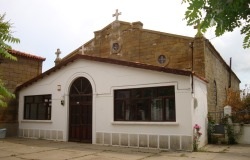 To reach most of the island’s other settlements you’ll need your own transport or a taxi; they were apparently built on long, twisting roads high up above the valleys so that the inhabitants would have fair warning of pirate raids.
To reach most of the island’s other settlements you’ll need your own transport or a taxi; they were apparently built on long, twisting roads high up above the valleys so that the inhabitants would have fair warning of pirate raids.
Best known is Tepeköy where you could be forgiven for thinking you had somehow grabbed a flight and wound up in Greece itself.
Centrepiece of the village used to be the Baba Yorgo pension on the main square which looked even more like a taverna than the lokantas of Bozcaada. However, this has now moved to the outskirts across from the ruinous old school, taking with it much of the village’s old Greek flavour. In the centre a compound encloses the church and the school that was once as much a part of a Greek religious complex as a medrese was of a külliye (mosque complex). Beside it, pretty stone houses fall away on all sides, offering spectacular views over the mountainous interior.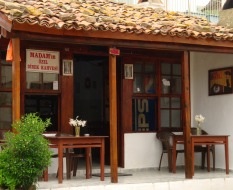
Recently attractive little Zeytinli has stolen some of Tepeköy’s thunder. It has its own hotel, too, which is unexpectedly pricy for somewhere so out of the way. About 50 or so people still live here, most of them apparently making a living from selling dibek kahvesi, a version of the normal thick Turkish coffee made from beans ground down in a giant marble mortar (dibek) rather than in a machine.
Dereköy, once the biggest village on the island (and some say in the whole of Turkey), is now so sparsely inhabited that there are barely enough residents to gather the figs that lie forgotten in the cobblestone streets. Better known Kayaköy, near Fethiye, was abandoned following the population exchange of 1923 but, like Bozcaada, Gökçeada was exempted from the terms of the Treaty of Lausanne that concluded the Turkish War of Independence so the stones of Dereköy tell another story, not quite so comfortably distant in history, because it wasn’t until first the Wealth Tax of 1942 and then the tensions aroused by the Cyprus dispute in the 1960s that most of the Greeks of Turkey’s two inhabited Aegean islands finally decided that they would have to leave their homes.
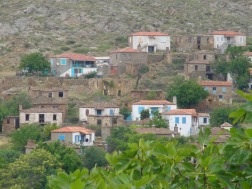 The ruins of Dereköy may not be as old as those of Karaköy, but they still make an evocative sight, the narrow streets full of ghosts who compete for attention with the goats and chickens of the small remaining community.
The ruins of Dereköy may not be as old as those of Karaköy, but they still make an evocative sight, the narrow streets full of ghosts who compete for attention with the goats and chickens of the small remaining community.
Dereköy means “Valley Village” and the settlement is interesting because, unlike the island’s other, older villages, it straggles up and down the slopes of the hills rather than hunkering down on top of them. Two churches, both locked but in good condition, testify to the size of the population that once lived here.
At the far side of the island, near Uğurlu, there’s another small but not very inspiring stretch of sand overlooked by the enormous Mavi Su Resort, a hotel and cabin complex created out of what was once a government building and still looks as if that’s what it should be. For something a little more inviting, you should head for Şirinköy, 2 km inland, which is wall-to-wall family-run pensions.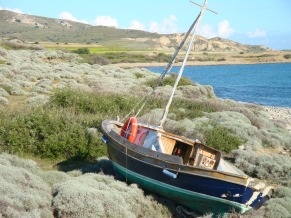
Sleeping
Both Yenibademli, near Kaleköy, and Şirinköy are full of small pensions. Except around 15 August, when Greeks return to the island en masse, you should be able to find somewhere cheap to stay.
Anemos Imvros Resort, Yukarı Kaleköy. Tel: 0286-887 3729
Barba Yorgo, Tepeköy. Tel: 0286-887 4247
Club Masi Hotel, Eski Bademli. Tel: 0286-887 4619
Gökçeada Sörf Eğitim Merkezi (Surfing Centre), Aydıncık. Tel: 0286-898 1022
Otel Özbek, Gökçeada Town. Tel: 0286-887 3600
Yakamoz Motel, Yukarı Kaleköy. Tel: 0286-887 2057
Zeytindalı Hotel, Zeytinli. Tel: 0286-887 3707
Transport info
Gestaş runs daily ferries to Gökçeada from Kabatepe, near Eceabat, and less frequent ones from Çanakkale. For details go to: https://www.gdu.com.tr/
Dolmuşes meet the ferries but only run visitors as far as Gökçeada Town.
There are minibuses from Gökçeada Town to Yenibademli and Kaleköy. Otherwise, those without cars will need to use taxis to get around the island.
